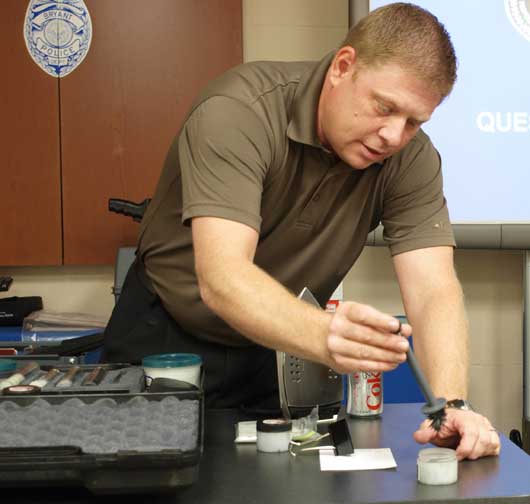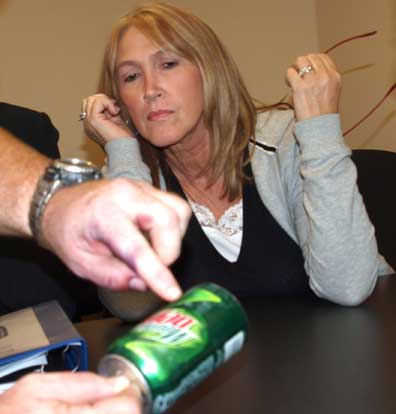 By LANA CLIFTON
By LANA CLIFTON
Tuesday, Oct. 20, was “CSI” night for participants of the Citizen’s Police Academy held by the Bryant Police Department.
Sgt. Jenceson Payte explained general crime scene investigation procedures to the class.
He said the first officer on the scene was usually a patrol officer. As the Initial Responding Officer (IRO), this officer has the responsibility to begin the initial stages of an investigation and to call a detective for serious or unusual crimes. The IRO of the case must also establish a perimeter and make sure all officers arriving on the scene know what is going on. Establishing and maintaining crime scene integrity starts with the IRO.[more]
“IRO’s have the best opportunity to preserve evidence in its most pristine condition,” said Payte. He also said they may have to testify in court years later about the crime scene.

One of the responsibilities the IRO must take on is keeping unnecessary personnel out of the crime scene. This could include neighbors, family members, media and even residents of the crime scene. Payte said this must be done to make sure no evidence is altered or destroyed.
“It’s not a conspiracy,” assured Payte. “It’s just to preserve the crime scene.”
During the initial investigation, everyone in the crime scene will be documented and escorted away from the scene. Payte said this does not mean they are all suspects. Witnesses must be documented in case they are needed to testify in a trial.
Payte also said it was standard procedure to keep witnesses separated.
“This is not because we don’t believe people,” explained Payte, “but because we want to get to the bottom of what happened.” He said sometimes what one person says may unintentionally influence another person’s observations.
If the case warrants it, an investigative officer, usually a detective, will be called to the scene. The IRO will tell the detective the facts of the case as they are known at that time. The detective will then conduct a search of the crime scene to search for evidence and will conduct interviews with witnesses and suspects. He will log, sketch, package, photograph and transport evidence. During this time, Payte said, all officers have to continue to be careful not to disturb evidence. He said, once evidence is located, it should never be moved (unless it has to be to preserve a life) until it is completely documented and ready to process.
“Scene integrity is very important,” stressed Payte.
After all evidence has been documented, it is processed. Payte said, in most cases, the procedures to process evidence are not like the CSI television show. He said the show either uses tools, gadgets and methods that don’t exist or it takes real things and twists them.
Corp. Det. Todd Crowson of the Bryant Police Department demonstrated some of the processing methods actually used by the police department.
He took the participants on a tour of the evidence room and evidence lockers showing them the procedures for documenting evidence and maintaining a proper chain of command.
Back in the classroom, Crowson brought out the gadgets everyone in the class had been waiting to see.
He demonstrated several methods for identifying fingerprints. He used magnetic fingerprint powder first, showing how the black powder sticks to the oils left behind by a person’s skin.
For darker surfaces on which the black magnetic powder will not show, sometimes investigators use a florescent powder. This powder is applied to an item with a special feather brush. After the powder is applied, the investigator shines a special light with an orange filter onto the item to search for a print. If one is visible, the investigator will take a photo of the print through the filter. The photo becomes evidence of the print.
To lift fingerprints off paper, detectives use a chemical spray called ninhydrin. The spray will show the fingerprint after a couple of days, but steam can be used to speed the process. Crowson used a steam iron to demonstrate this method. After applying the spray and holding a steam iron over the paper, the print turned purple.
Crowson used a glass aquarium with a lid, two small trays, some super glue and water for the other fingerprint lifting method. After putting the small trays inside the aquarium, he placed a few drops of super glue in one tray, some warm water in the other, placed a Mountain Dew can on the bottom of the aquarium, closed the lid and waited. After a few minutes, the fumes from the glue had adhered to the sides of the can making the fingerprint clearly visible.
Crowson also demonstrated the use of a special film and a device that applied an electric charge to create static electricity. This was used to lift a footprint.
Crowson said if evidence is collected that needs to be processed, like fingerprints or DNA, it is sent to the state crime lab in Little Rock. He said throughout the whole process of finding, processing and moving evidence, a strict procedure is followed to follow the chain of custody of evidence to make sure it is not tampered with.
The Bryant Police Department currently has three detectives. They handle investigations of all felony cases. As the population of Bryant has increased, so have the number of felony cases. In 2003, there were 258 felony cases filed and Bryant had two detectives. In 2004, that number almost doubled to 443. The department added the third detective to accommodate the increase. In 2008, there were 561 felony cases filed. By the end of September in 2009, 401 cases had already been filed.
Crowson said most of these cases are of a financial nature, such as forgery, or breaking and entering. He said drug cases are on the rise.
Payte said the number of cases filed creates a never-ending job for the detectives. They must process and investigate new crimes while keeping old cases going. He complimented the detectives in Bryant for being diligent and doing their best to keep up with a growing case load.
“[Investigating crime] is not just about tools, but about knowing your jobs,” said Payte. “Each detective in Bryant has something to bring to the table.”
